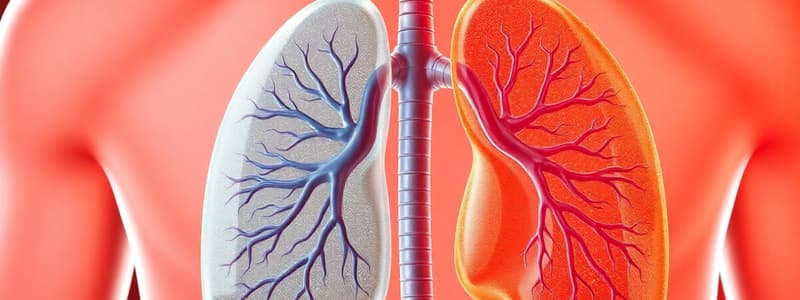Podcast
Questions and Answers
ما هو التنفس الخلوي؟
ما هو التنفس الخلوي؟
هو احدى العمليات الخلوية التي تتطلب الأوكسجين وتعطي ثنائي أوكسيد الكاربون. وهي تتضمن تكسير الكلوكوز كاملا إلى ثنائي أوكسيد الكاربون وماء وكذلك الى الطاقة.
ما هو الأيض؟
ما هو الأيض؟
- يقصد بالايض الخلوي كل العمليات الكيميائية التي تحدث في الخلية
- تبادل المادة والطاقة بين الخلية وبيئتها (correct)
- جميع العمليات الكيميائية التي تحدث في الخلية
- يقصد بالايض الخلوي جميع العمليات الكيميائية التي تحدث في الجسم الحي
ماذا تقصد بـ "التنفس الخارجي" ؟
ماذا تقصد بـ "التنفس الخارجي" ؟
هو عملية التبادل الغازي بين الدم والمحيط الخارجي.
اطلب منك مطابقة ما يُشير اليه كل وصف مما يلي
اطلب منك مطابقة ما يُشير اليه كل وصف مما يلي
من هم من يعتمدون على التنفس الجلدي
من هم من يعتمدون على التنفس الجلدي
ما هو جهاز الرغاموي أو القصيبي؟
ما هو جهاز الرغاموي أو القصيبي؟
تسمى فتحة الجهاز الرغاموي في الحشرات بالمتنفّس .
تسمى فتحة الجهاز الرغاموي في الحشرات بالمتنفّس .
ما هي مواصفات الهواء الذي يصل الى الحويصلات الهوائية للرئات؟
ما هي مواصفات الهواء الذي يصل الى الحويصلات الهوائية للرئات؟
ما هي أبرز المميزات في تركيب الجهاز التنفسي في الانسان ؟
ما هي أبرز المميزات في تركيب الجهاز التنفسي في الانسان ؟
ما هو العامِل الذي يُحافظ على امتداد الرئتين داخل التجويف الصدري؟
ما هو العامِل الذي يُحافظ على امتداد الرئتين داخل التجويف الصدري؟
ما هي أبرز سمات التهوية في الطيور؟
ما هي أبرز سمات التهوية في الطيور؟
تستثنى السلحفاة من الزواحف التي تلعب الاضلاع والعضلات الضلعية فيها دورًا رئيسيًا في عملية التبادل الغازي.
تستثنى السلحفاة من الزواحف التي تلعب الاضلاع والعضلات الضلعية فيها دورًا رئيسيًا في عملية التبادل الغازي.
التهوية في الضفدع تتم بواسطة "ضغط سالب"
التهوية في الضفدع تتم بواسطة "ضغط سالب"
ما الوصف الصحيح لتركيب الاجهزة التنفسية في البرمائيات?
ما الوصف الصحيح لتركيب الاجهزة التنفسية في البرمائيات?
أذكر ما هي مراحل التنفس في الانسان?
أذكر ما هي مراحل التنفس في الانسان?
أين تُحدّث عملية التبادل الغازي في الانساء؟
أين تُحدّث عملية التبادل الغازي في الانساء؟
Flashcards
التنفس الخلوي
التنفس الخلوي
عملية خلوية تحتاج الأكسجين وتُنتج ثاني أكسيد الكربون، وتُجزئ الكلوكوز لإنتاج الطاقة.
مراحل أكسدة الكلوكوز
مراحل أكسدة الكلوكوز
تتضمن أربعة مراحل رئيسية لتحليل الكلوكوز وإنتاج الطاقة داخل الخلية.
البناء الضوئي
البناء الضوئي
عملية في النباتات تُنتج الغذاء وتحوِّل الطاقة الضوئية إلى طاقة كيميائية.
التبادل الغازي في النباتات
التبادل الغازي في النباتات
Signup and view all the flashcards
الثغور
الثغور
Signup and view all the flashcards
العديّسات
العديّسات
Signup and view all the flashcards
التنفس الخارجي
التنفس الخارجي
Signup and view all the flashcards
التنفس الداخلي
التنفس الداخلي
Signup and view all the flashcards
التنفس الخلوي الهوائي
التنفس الخلوي الهوائي
Signup and view all the flashcards
الجهاز التنفسي في الإنسان
الجهاز التنفسي في الإنسان
Signup and view all the flashcards
الحويصلات الهوائية
الحويصلات الهوائية
Signup and view all the flashcards
انتقال الغازات في الدم
انتقال الغازات في الدم
Signup and view all the flashcards
التنفس الجلدي
التنفس الجلدي
Signup and view all the flashcards
الهيموغلوبين
الهيموغلوبين
Signup and view all the flashcards
التنفس الرغاموي
التنفس الرغاموي
Signup and view all the flashcards
الخياشيم
الخياشيم
Signup and view all the flashcards
الرئات
الرئات
Signup and view all the flashcards
الضغط الجزئي
الضغط الجزئي
Signup and view all the flashcards
أكسدة
أكسدة
Signup and view all the flashcards
التحلل السكري
التحلل السكري
Signup and view all the flashcards
المايتوكوندريا
المايتوكوندريا
Signup and view all the flashcards
NADH
NADH
Signup and view all the flashcards
Study Notes
Chapter 2: Respiration & Gas Exchange
- This chapter discusses respiration and gas exchange in living organisms.
- The chapter is divided into sections, including:
- Introduction
- Cellular Respiration
- Plant Respiration
- Animal Respiration
- Chapter Questions
Learning Objectives
- Students will be able to define cellular respiration.
- Students will be able to explain the four stages of glucose oxidation in cellular respiration.
- Students will be able to compare photosynthesis and respiration in plants.
- Students will be able to explain the mechanics of gas exchange in plants.
- Students will be able to define stomata and lenticels, and compare them.
- Students will be able to compare external and internal respiration.
- Students will be able to explain the concept of aerobic cellular respiration.
- Students will be able to explain the mechanics of respiration in animals.
- Students will be able to define pulmonary (alveolar) respiration.
- Students will be able to explain the concept of cutaneous respiration in vertebrates.
- Students will be able to explain the mechanics of respiration in birds.
- Students will be able to list the parts of the human respiratory system.
- Students will be able to explain the function of each part of the human respiratory system.
- Students will be able to explain the mechanism of inhalation and exhalation in humans.
- Students will be able to describe the structure of alveoli in the lungs.
- Students will be able to explain the process of gas exchange in the blood.
Introduction (1-2)
- Early organisms obtained energy from glucose through glycolysis.
- Glycolysis splits glucose into two molecules of pyruvic acid, releasing some energy.
- Most cells use glycolysis to produce energy.
- Early organisms likely cycled between photosynthesis and glycolysis.
- Glycolysis releases less than 0.1% of the energy stored in glucose produced during photosynthesis.
Cellular Respiration (2-2)
- Cellular respiration is a process requiring oxygen, producing carbon dioxide.
- Complete breakdown of glucose into carbon dioxide, water, and energy.
- Cellular respiration involves enzymatic processes.
- External Respiration is the exchange of gases between the blood and the external environment.
- Internal Respiration is the gas exchange between the blood and the body's cells.
- The process involves multiple steps (glycolysis, preparatory reaction, citric acid cycle, electron transport chain).
- Cellular respiration produces ATP, a crucial energy source for life.
Respiration in Plants (3-2)
- Plants lack specialized respiratory organs but exchange gases through their tissues.
- Gases enter and exit through stomata (and lenticels in woody stems).
- Oxygen diffuses into plant cells and carbon dioxide diffuses out.
- During the day, photosynthesis and respiration both occur, with photosynthesis generally exceeding respiration.
- At night, only respiration occurs.
Respiration in Animals (4-2)
- Animals require oxygen for metabolic processes to remove carbon dioxide.
- Various methods of gas exchange exist (e.g., body wall, gills, lungs).
- External Respiration in animals involves gas exchange between the respiratory surface and the blood.
- Internal Respiration in animals involves gas exchange between the blood and the body's cells.
- Animals use various respiratory systems based on their environment.
Mechanisms of Respiration
- Different organisms have different respiratory mechanisms.
- Simple diffusion is used for gas exchange in single-celled organisms.
- More complex organisms have specialized respiratory systems with moist surfaces for gas exchange.
- Types of Systems include:
- Cutaneous respiration
- Gills
- Tracheal systems
- Lungs
Respiration in Invertebrates
- Cutaneous - Skin respiration. This allows for gas exchange in flat or thin-bodied invertebrates.
- Gills are used by aquatic animals.
- Tracheal systems are the respiratory structures of many terrestrial arthropods (insects).
Respiration in Vertebrates
- Cutaneous respiration is used by some vertebrates (e.g., amphibians).
- Gills are the primary respiratory system for many aquatic vertebrates.
- Lungs form in vertebrates to support respiration on land.
Ventilation in Amphibians, Reptiles, Birds, and Mammals
- Amphibians, reptiles, birds, and mammals demonstrate different ventilation strategies.
- Ventilation in each class allows for gas exchange in their respiratory systems.
- Key differences in structures and mechanisms are described.
Gas Exchange
- Gases move according to diffusion gradients (high pressure to low pressure).
- Gaseous exchange in the lungs follows physical principles of diffusion.
- Gas exchange involves a moist surface for diffusion across cell membranes.
- Differences in gas pressures drive the exchange of oxygen and carbon dioxide.
Gas Transport in the Blood
- Haemoglobin is the primary oxygen-carrying pigment in blood; it combines with oxygen to form oxyhemoglobin (a reversible reaction)
- Some carbon dioxide is carried dissolved in the blood plasma.
- The rest of the CO2 combines with water to form carbonic acid, which then dissociates into hydrogen and bicarbonate ions.
Other Important Concepts
- Breathing and gas exchange are critical for life.
- Various respiratory structures and mechanisms exist in different organisms to facilitate these processes.
Studying That Suits You
Use AI to generate personalized quizzes and flashcards to suit your learning preferences.




